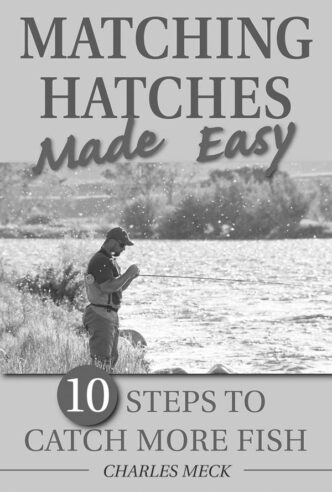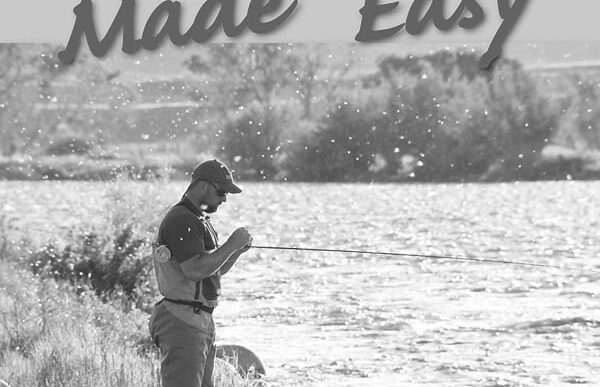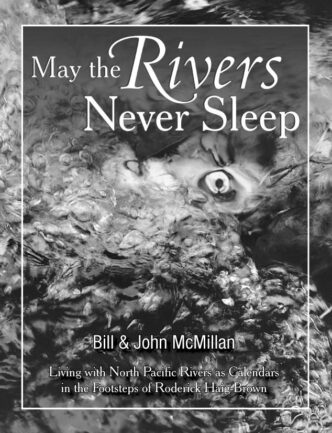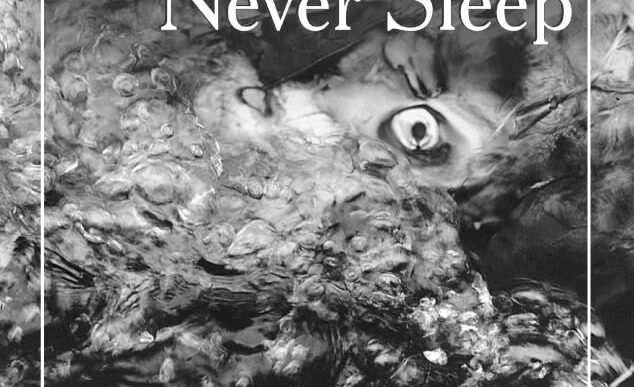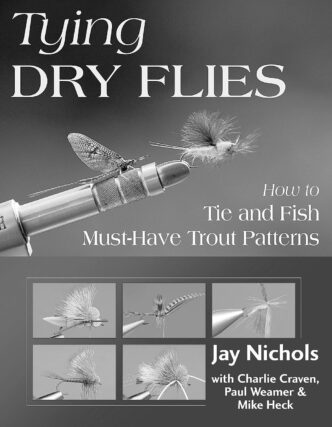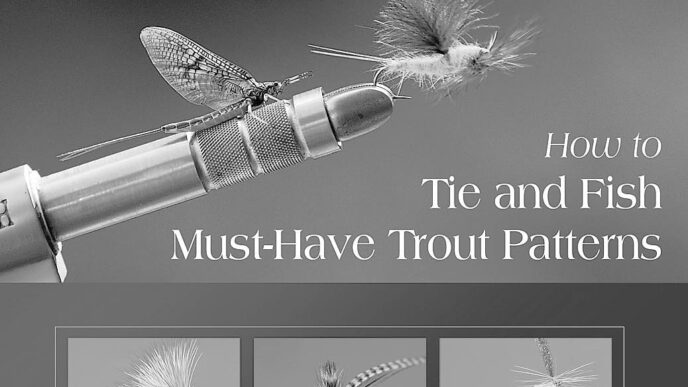Switch Rod Casting Techniques
DVD by Jeff Putnam’s Fly Fishing Schools, 2011; $34.95, 93 minutes.
Jeff Putnam has been a fixture in the Sacramento-area flyfishing scene for at least as long as this magazine has been in print, and a few years back, he established a fly-fishing school that not only provides on-stream instruction, but instructional videos and online learning, as well (see jpflyfishing.com). One of his more popular DVDs is Switch Rod Casting Techniques. Switch rods are longer than single-handed fly rods, but not as long as Spey rods, and they are designed to be cast with both singlehanded and double-handed techniques. Although there are certainly fly fishers who believe that this means switch rods can’t perform either function well, Jeff Putnam states early in this video that “switch rods are one of the most practical tools for fly fishing,” and he then demonstrates why this is the case. The length of switch rods, for example, gives them an advantage over singlehanded rods for extending one’s reach and drift when fishing dries, nymphs, and wet flies, and the ability to use Spey techniques means such rods have great utility when room for back casting is constrained. But one can also cast shooting heads and regular fly lines with standard single-handed overhead-casting techniques, thus broadening tactical applications. And these are indeed broad. Putnam plies his switch rods not just along trout and steelhead rivers, but, more intriguingly, in the saltwater environments of the surf zone and coastal estuaries. (It’s nice to see him placing emphasis on challenging fisheries such as these, where we’re all still figuring out how best to fish them.) Much of the advice that he provides will, in fact, prove useful for fly fishers irrespective of whether they ever angle with a switch rod.
As a novice Spey caster myself, I found Putnam’s descriptions of switch-rod tackle and of the basic Spey casts (including the double Spey, the snap-T, and the snake roll) to be more than adequate for helping me in my own advance up the leaning curve. He speaks clearly and well, and his casts are shown several times and from different angles, including overhead, which better allows us to visualize proper rod and arm motions. With almost no effort, he uses the switch rod to cast the line 60 feet, and in one section of the video, he’s apparently fishing 100 feet out, which is pretty impressive when there’s no room for double hauling and which again shows that one doesn’t have to use a heavier Spey rod to achieve this distance.
In all, Switch Rod Casting Techniques will certainly have you contemplating whether you should add another rod to your collection, and whether you do or not, it will likely improve your competency as a caster and fly fisher.
Richard Anderson
A Man May Fish
By T. C. Kingsmill Moore. First published in 1960. Second, revised edition published by Colin Smythe Ltd., 1999; $35.00, hardbound.
T. C. Kingsmill Moore fished the rivers of Ireland at a time when some of its people still believed in fairies. One day while fishing, he met a lad who told him that as a small boy, he had been stolen by fairies, only to be returned to hearth and home because he would neither eat nor drink for a fortnight. The fairies had given him “the whisper and the touch for a sick cow.”
It was as natural for country Irish to speak of fairies as to comment on the weather. Or gather on the riverbank to offer advice the moment an angler hooked a salmon. Or invite the fisherman back to the cottage for a “sup” of poteen from an illegal still.
T. C. Kingsmill Moore was definitely “old school.” For almost the entirety of his long angling life, his rods were made of greenheart or split cane, his casts of silkworm gut, and his lines of oiled silk. One day while walking back from the river to the hotel after a day of fishing, he passed a pair of laborers and overheard one to say to the other in Gaelic, “There goes the last of the ould lot, and he’s sticking it out well.”
Near the end of a half-century of fishing — and contemplating the toll that pollution and drift netting had taken of late on his beloved Irish rivers — Kingsmill Moore wrote: “I was fortunate to have been born in 1893.”
Kingsmill Moore served several terms in the Irish Senate, was a judge of the Irish High Court, and later a justice of the Supreme Court of Ireland. But it was said of him in jest that his real profession was fishing. He was unquestionably Ireland’s finest angling writer. His nearest counterpart on the North American continent — in terms of angling, writing, and public service — would be Roderick Haig-Brown. A Man May Fish is Kingsmill Moore’s summation of a lifetime spent angling. He put everything he knew about fishing for brown trout, sea trout, and salmon on the rivers of western Ireland into a memoir that, by all rights, should be as famous as Haig-Brown’s books.
A Man May Fish is not just an angling book. It is a window on Ireland’s culture and the Irish people. In his book, Kingsmill Moore seems to be describing a lost world of pastoral integrity. As a boy, he witnessed Andrew Lang, the legendary author of the Fairy Books, hook and land what was probably the old man’s final salmon. Kingsmill Moore also recounts that when he was a youngster, a water bailiff once nicked him for poaching, but let him go with a warning after the boy proffered a lame excuse. Forty years later, that same bailiff appeared in the judge’s courtroom to give testimony in a case. The judge didn’t recognize him, but the bailiff certainly remembered Kingsmill Moore. When the judge casually asked if there might be a good run of sea trout in a certain river, the bailiff replied, “Faith and there is, and your lordship wouldn’t be long in whipping them out.”
All fishing stories have their “characters,” and there are characters aplenty in Kingsmill Moore’s angling memoir. Take “Jamesie,” the judge’s feckless boatman, who may have told more tall ones than Barry Fitzgerald in The Quiet Man. The Judge seems to have taken quite a shine to his cunning boatman. He just wasn’t about to take anything Jamesie told him at face value. After all, the judge had seen far too many villains standing before him in the dock to be that credulous.
A Man May Fish will not be mistaken for Ivan Turgenev’s A Sportsman Sketches. But the author brings his characters fully to life and grants them their full share of humanity. And there’s plenty of atmosphere, what with tales of haunted uplands. and fairy passes, and descriptions of fishing for sea trout: “As the night deepens the river takes command. Its voice mounts, filling the valley, rising to the rim of the hills, no longer one voice but a hundred. Time and place are dissolving; the centuries have lost their meaning; timelessness is all.”
There is an old Celtic saying: “An rud is annamh is iontach” — “What’s seldom is wonderful.” What could be more wonderful — or seldom, these days — than a salmon on the end of your line? Or a one-of-a-kind book such as this?
Michael Checchio
Editor’s note: a more recent edition of A Man May Fish was published by Colin Smythe in 2004, with a preface by the noted British angler Hugh Falkus. It is more expensive than the 1999 book, retailing for approximately $60.
The Ohlone Way: Indian Life in the San Francisco–Monterey Bay Area
By Malcolm Margolin. First published in 1978. Published by Heyday Books, 2003; $16.95 softbound.
All of us are descendents of hunter-gatherers. As anglers, we are more closely connected to this heritage than most of our fellow urbanites. Those connections lie deep in our past, yet in California, we are only a bit more than two hundred years removed from a time when a culture lived completely on and in the land.
Malcolm Margolin’s The Ohlone Way, first published in 1978, kindled a revolution in the awareness of Native American culture in California and beyond. The book was selected by the San Francisco Chronicle as one of the top 100 Western nonfiction books of the twentieth century.
In the introduction, Margolin tells us that “before the coming of the Spaniards, Central California had the densest Indian population anywhere north of Mexico.” It was estimated that ten thousand people lived between Point Sur and the northern reaches of what would be called San Francisco Bay. Margolin asked: “What was life like in the Bay Area before the coming of the Europeans.” Ironically, it was principally from accounts left by early European arrivals in what was to become California that he could begin to answer that question, but fortunately, “the early Spanish explorers and missionaries were passionate keepers of diaries and journals, as well as prolific writers of letters and official reports.” There were also reports and even travelogues from ship captains, adventurers and traders. (Margolin’s references and bibliography have given me a fascinating reading list that will last long into my life.) Early on in the first chapter of part 1, “Land and Animals,” we get a glimpse at what was one of the most abundant areas on earth. One explorer described it as a land of “inexpressible fertility.” In just a few pages of beautiful descriptions, you will cry for what has been lost.
In his journal, Father Juan Crespi called the geese population “uncountable.” Silver salmon and steelhead journeyed up most small streams. Chinook salmon migrated up the great rivers, and their progeny developed and grew in the rich estuaries. Trout lived in the tributary creeks. Unaltered salt and freshwater marshes teemed with resident and migratory fish. Herds of elk, antelope, and deer grazed on coastal plains and hillsides and mingled with huge packs of grizzlies and black bears that fed opportunistically on crops of acorns, game, fish, and even beached whales. Flocks of resident birds mingled with migratory and resident flocks of geese, cranes, pelicans, and ducks that flourished in a much more watery environment.
In subsequent chapters of part 2, “Life in a Small Society,” Margolin describes the native peoples who had inhabited this land for thousands of years. He shows us how life in their small society evolved to exist harmoniously in such a place. We get a look at life cycles, a culture of sharing, trade, and sensible forms of warfare, hunting, fishing, and gathering.
Part 3, “The World of the Spirit,” elaborates on the spiritual, rather than the natural or social worlds that the Ohlone inhabited. Theirs was “a view of the world that bestows life on all things.” His explanation of the animist concepts underlying this worldview is the best that I have encountered in my readings on Native American life. And as Margolin says in the introduction, this book is not just about “the Ohlone way”: “If we look long enough, if we dwell on their fears and reverence, we may in the end catch a glimpse of almost forgotten aspects of our selves.”
This is a powerful book that tells of a society not to far removed in either time or space from our own. It’s a book with an appeal for anglers and anyone who wants a deeper understanding of their environment. If we are to be stewards of our land, we need to know more about it.
Trent Pridemore




